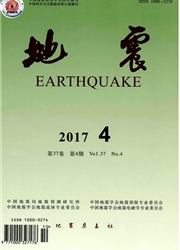

 中文摘要:
中文摘要:
基于中国大陆构造环境监测网络的连续重力观测数据,对于田MS7.3地震、鲁甸MS6.5地震、景谷MS6.6地震和皮山MS6.5地震前几天的重力扰动信号主频率特征及2014年台风"威马逊"、"麦德姆"和"黄蜂"引起的重力扰动主频率特征进行了研究。结果表明:震前重力扰动信号和台风引起的重力扰动信号频率范围很接近,对应周期为4-7s,单从频率大小无法对两者进行区分;在不受台风影响的情况下,不同台站震前重力扰动信号主频率极差和标准差均小于0.02Hz,而台风引起的不同台站重力扰动信号主频率极差和标准差均大于0.02Hz;通过主频率极差和标准差这两个指标可以很好地将震前重力扰动与台风引起的重力扰动进行有效区分,这将大大推进连续重力观测在强震短临监测中的应用,为构建地震预报定量指标体系提供相关依据。
 英文摘要:
英文摘要:
We carried a research on main frequency characteristics of gravity disturbance signals before Yutian MS7.3,Ludian MS6.5,Jinggu MS6.6and Pishan MS6.5earthquakes,as well as gravity disturbance signals induced by typhoon‘Huangfeng',‘Weimaxun',and‘Maidemu',based on continuous gravity observations from Crustal Movement Observation Network of China(CMONOC).The results show that the gravity disturbance signals before earthquake and induced by typhoon cannot be distinguished with its main frequency which is similar and all correspond to 4-7s.The range and standard deviation of gravity disturbance signals before earthquake are both lower than 0.02 Hz without any influence of typhoon,in contrast,they are both higer than 0.02 Hz when it is induced by typhoon.The range and standard deviation of main frequency can be used to separate the gravity disturbance signals before earthquake from typhoon effect.This work will greatly improve the applications of the continuous gravity observations in earthquake short-term monitoring.
 同期刊论文项目
同期刊论文项目
 同项目期刊论文
同项目期刊论文
 期刊信息
期刊信息
